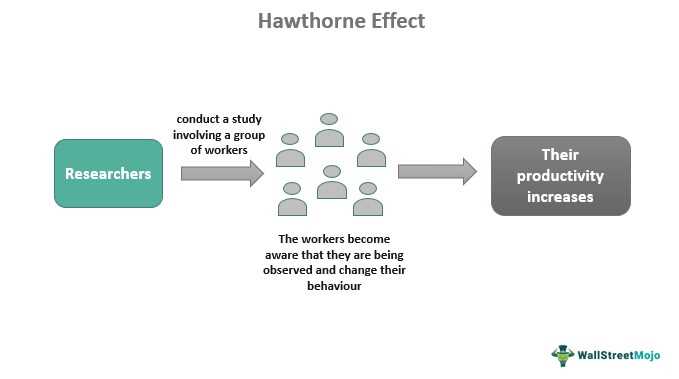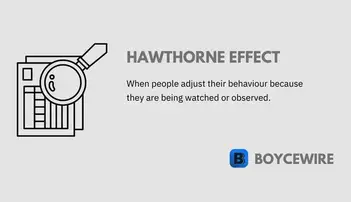Definition of the Hawthorne Effect

The Hawthorne Effect refers to the phenomenon where individuals modify their behavior or performance when they are aware that they are being observed. It is named after a series of studies conducted at the Western Electric Hawthorne Works in Chicago during the 1920s and 1930s.
The original purpose of the studies was to examine the relationship between lighting conditions and worker productivity. However, the researchers discovered that regardless of the changes in lighting, worker productivity consistently increased. This unexpected finding led them to investigate other factors that may have influenced the workers’ behavior.
It was found that the mere act of being observed and receiving attention from the researchers had a significant impact on the workers’ performance. They felt motivated to work harder and demonstrate their abilities, leading to improved productivity. This effect was observed across various tasks and industries, suggesting that it is a general phenomenon.
The Hawthorne Effect can be attributed to several factors. Firstly, the presence of observers creates a sense of importance and accountability among individuals, making them more conscious of their actions. Secondly, the attention and interest shown by the researchers may enhance the workers’ self-esteem and confidence, leading to increased effort. Lastly, the workers may perceive the study as an opportunity to showcase their skills and abilities, which further motivates them to perform better.
However, it is worth mentioning that the Hawthorne Effect is not without criticism. Some argue that the effect may be temporary and diminish over time as individuals become accustomed to being observed. Others question the validity of the effect, suggesting that the observed improvements in performance may be due to other factors, such as increased motivation or changes in the work environment.
Mechanism of the Hawthorne Effect
The Hawthorne Effect is a psychological phenomenon that refers to the alteration of behavior when individuals are aware that they are being observed. It was first observed during a series of studies conducted at the Western Electric Hawthorne Works in Chicago between 1924 and 1932. The studies were aimed at investigating the relationship between lighting conditions and worker productivity.
Initially, the researchers hypothesized that increased lighting would lead to improved productivity. However, they found that productivity increased regardless of whether the lighting conditions were improved or not. This unexpected finding led the researchers to conclude that factors other than lighting were influencing worker productivity.
One of the main mechanisms behind the Hawthorne Effect is the psychological response of individuals to being observed. When individuals know that they are being watched, they may alter their behavior in order to conform to the expectations of the observer or to present themselves in a favorable light. This can result in an increase in productivity or performance, even if the observed factor (such as lighting) has no direct impact on the outcome.
Another mechanism that contributes to the Hawthorne Effect is the social dynamics within a group. The studies conducted at the Hawthorne Works revealed that workers’ productivity increased not only when they were observed individually, but also when they were observed as part of a group. This suggests that the presence of others and the social pressure to perform well can influence individual behavior and productivity.
Implications and Limitations
The Hawthorne Effect has important implications for research and management practices. It highlights the need to consider the potential influence of observation and social dynamics on study outcomes and employee performance. Researchers and managers should be aware that the mere act of observing individuals can lead to changes in behavior and performance, which may affect the validity of the results.
However, it is important to note that the Hawthorne Effect has its limitations. It may not be applicable in all situations, and its magnitude can vary depending on individual and contextual factors. Additionally, the Hawthorne Effect is often considered a temporary phenomenon, as individuals may eventually become accustomed to being observed and revert back to their original behavior.
Conclusion
Validity of the Hawthorne Effect
The Hawthorne Effect is a phenomenon that has been widely studied and debated in the field of social sciences. It refers to the alteration of behavior that occurs when individuals are aware that they are being observed or studied. While the Hawthorne Effect has been widely accepted as a valid concept, there are some criticisms and limitations to its validity.
Criticism of the Hawthorne Effect

One of the main criticisms of the Hawthorne Effect is that it may not be a true effect, but rather a result of other factors. Some argue that the changes in behavior observed in studies attributed to the Hawthorne Effect may be due to other factors, such as increased attention from researchers or the novelty of the situation. Additionally, some studies have failed to replicate the findings of the original Hawthorne studies, casting doubt on the validity of the effect.
Another criticism is that the Hawthorne Effect may only be applicable in certain situations or contexts. For example, it may be more likely to occur in laboratory settings or in studies that involve repetitive tasks. It may not be as relevant in real-world settings or in studies that involve more complex or meaningful tasks.
Limitations of the Hawthorne Effect
Another limitation is that the Hawthorne Effect may not be applicable to all individuals or groups. Different individuals may respond differently to being observed, and certain groups may be more or less susceptible to the effect. Factors such as personality traits, cultural background, and individual motivations may influence the extent to which individuals are affected by the Hawthorne Effect.
Conclusion
While the Hawthorne Effect has been widely accepted as a valid concept, it is important to recognize its limitations and consider alternative explanations for observed changes in behavior. Further research is needed to better understand the mechanisms and boundaries of the Hawthorne Effect and its implications for various fields of study.

Emily Bibb simplifies finance through bestselling books and articles, bridging complex concepts for everyday understanding. Engaging audiences via social media, she shares insights for financial success. Active in seminars and philanthropy, Bibb aims to create a more financially informed society, driven by her passion for empowering others.
